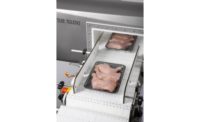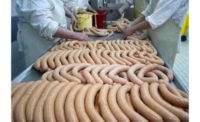What’s the Frequency?
By Lynn Petrak, special-projects editor
Livestock tagged with RFID technology enhance management, health and quality.
The question arises with every news headline linked to animal health or food safety: What if there was a better way to identify and track animals back through the food chain? What if we could quiet controversies with clear, concise and immediate data?
Whenever reports of possible cases of bovine spongiform encephalopathy (BSE) arise and impact consumer and importer confidence, industry leaders start talking about better ways to manage protein sources from farm to plate. Likewise, when consumers are sickened and products recalled due to pathogens like E. coli O157:H7 or when the public learns about the possibility of deadly strains of avian flu affecting the nation’s poultry flocks, there is a groundswell of interest in technology applied at the live animal level.
The use of radio-frequency identification (RFID) technology is often discussed in addressing such crises. While much of the focus in the past several years has been on RFID tags affixed to packaged goods for supply-chain management purposes, the technology also can be utilized in cattle, pigs and sheep for animal health and wellness reasons, as well as for track and trace, and carcass-quality information.
This technology has been around for decades and is proven across many industries. Basically, RFID tags identify a host — animal or finished product — through the use of radio waves. RFID tags incorporated into an animal contain small chip with a circuit for storing and processing information and an antennae for receiving and transmitting the signals. Data on an animal can be collected from birth to slaughter via a transponder, reader (also called a transreceiver), data accumulator device and processing software.
RFID tags are either active or passive. Passive tags are activated when a reader is close by to power them, while active tags and semi-passive tags have a power source of their own in the form of a small battery. In livestock applications, tags are commonly passive. That said, high-frequency tags are being developed to achieve more consistent and accurate readings.
RFID technology moved more into the forefront of the livestock industry in 2003, when the National Animal Identification System (NAIS) program was proposed by the United States Department of Agriculture (USDA). Following a pilot program in 2004, livestock producer participation in the NAIS has been on a voluntary basis, with the exception of Michigan. Last year, that state required cattle to be fitted with RFID tags as part of an effort to eradicate bovine tuberculosis.
As of early 2008, Michigan is still the only state with an RFID mandate, although the chairman of the Congressional House Agricultural Committee, Rep. Collin Peterson of Minnesota, recently remarked that full participation may be needed in the future, “to ensure that we have a system that meets the needs of livestock producers and the public.” Peterson pointed out that although $100 million has been invested in NAIS program, it is not functioning on a widespread basis.
The livestock industry, for its part, has supported the notion of animal identification systems, with organizations such as the National Cattlemen’s Beef Association (NCBA), NAIS Cattle Working Group, IDairy and United States Animal Identification Organization (USAOI) advocating the use of RFID tags. The how and why of animal ID technology, though, is still on the table, as many in the industry have voiced the opinion that animal ID programs are best when run without government management and oversight.
NCBA, which initially helped form the USAIO, gave up control of that body, which is now on inactive status, according to NCBA spokesperson Joe Schuele.
“The technology itself isn’t at a standstill — the organization reached the conclusion that it wasn’t going to be able to offer anything out there that wasn’t in the private sector,” he explains, adding that, although NCBA does not support mandated compliance with NAIS technologies, it is important to have options available and ready in the event that requirements are set in motion.
Rick Stott, executive vice president for beef producer and processor Agri Beef Co., Boise Idaho, says there is evidence to support the theory that free-market controls over animal ID work best.
“Australia and Canada discovered, and rightly so, that the industry should control the database. If you look at the countries in which government has driven it and forced it on the industry, it is extremely expensive,” he points out, noting that the cost per head of RFID incorporation is the U.S. equivalent of 10 dollars in the UK, where it is mandated, and less than 25 cents in Canada, where the system is managed independently.
Agri Beef, for its part, now uses tags and readers throughout its production and processing system in the Pacific Northwest region.
“From a practical standpoint, we are implementing 100 percent identification in our Northwest operation. We want to be able to identify every group of animals from the time we own them to the time they go into the blocks,” Stott says. According to Stott, RFID technology is worth the investment for many reasons, from time savings to eating experience.
“We think there is a tremendous opportunity to continue to improve the quality of our product,” he says, adding that the protection of the herd is paramount as well. “When the U.S. had the BSE incident, for example, the industry lost billions of dollars over the next few weeks because they couldn’t identify where the animals came from. I am convinced that if we could have said, ‘This animal is from Canada,’ right away, we could have averted much of the pain and suffering that has lingered still over the last three years.”
Doug Freeman, professor and head of veterinary and microbiological sciences at North Dakota State University, is working on high-frequency RFID tags and agrees that there are multiple benefits associated with the technology.
“It is trace back and trace forward, but the big impetus is in response to disease, like the spread of cases of BSE when USDA tries to trace animals back to their origin,” he comments. The fact that BSE has a long incubation period also makes traditional methods of traceback challenging, he adds.
In addition to the security of knowledge, Freeman points out that the technology must offer value to users in other ways. Carcass-quality information is valuable, as is the ability to most effectively manage livestock population.
“If you ask a producer in North Dakota how many cattle you have, they’ll ask how many dollars you have in our pocket,” he points out.
RFID within range
Cattle producers — and, for that matter, other livestock producers looking for better controls on the health and movement of their herds and flocks — can choose from different providers of RFID technology, including tags and software.
The technology is continually updated. Allflex USA, a Dallas-based provider of livestock identification systems, recently announced USDA approval of its ISO RFID tags for NAIS programs. Currently, Allflex offers two RFID technologies — Half Duplex and Full Duplex tags — for users in the livestock industry.
Y-Tex Corporation, a Cody, Wyo. manufacturer of ear tags, recently expanded into a new RFID tag. The weather-resistant tag is sold with a wireless reader, base station and Bluetooth® Tag Tracker and offers long read distance, retention and quick activation.
Meanwhile, Freeman, along with other project leaders at North Dakota State University, is working with cow-calf producers in Western North Dakota to equip cattle with active RFID tags. According to Freeman, high-frequency tags allow users to collect data with maximum efficiency, since tags can be read if animals are in a group, instead of on an individual basis as with low-frequency readers.
“If you are talking about a feedlot, you are slowing down the rate of commerce if you take too long to read it. And it has to be affordable, like a number tag,” he says.
Whether active or passive, improvements in RFID tags, as well as in readers, processing software and hand-held digital data accumulators, ultimately impact the market for such technology in a number of ways, including cost-effectiveness.
“We are seeing tremendous opportunity now, since ID tags are now cheap enough you can put them in most cattle. It’s between $1 and $2 a tag, and when you are talking about a $1,200 animal, it’s all relative,” Stott says of the passive tags that Agri Beef uses in its production and processing chain.
Active tags, though costlier, are also coming down somewhat in price. One of the goals of the project at North Dakota State University is to develop affordable RFID technologies. In addition to tags and transponders, software is also continually updated. Freeman, for his part, likens his accompanying software system to a digital safety-deposit box.
“The owner of the information can identify which information can be released to the USDA or to a sales yard or a packer,” he explains, adding that such features alleviate many users’ concerns about information security.
The next evolution in RFID technology may just be linking up the various fragments of the farm-to-plate chain. It is one thing to identify an animal from birth to slaughter and to track a package or pallet to a store or restaurant kitchen, but it is quite another to be able to move more seamlessly from animal to distributor.
“Certainly, we think that technology will continue to improve. And even though there are some hindrances — in most plants, it’s difficult to say which box one individual animal may go into — there will be improvements in a few short years,” predicts Stott.
Although producers may have ongoing concerns about the privacy of data, Freeman says that advancing RFID technology will be designed to address security as well as operational efficiency, animal health and food safety, because market pressure is the ultimate driver.
“As you hear more about people wanting to know where their food comes from, I think this will continue,” he says.



Report Abusive Comment